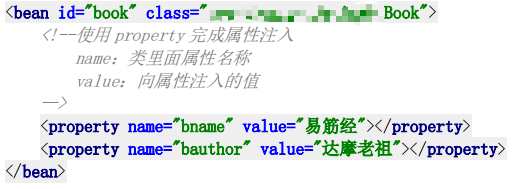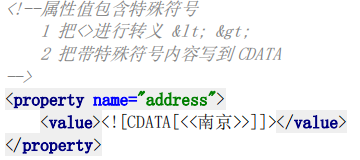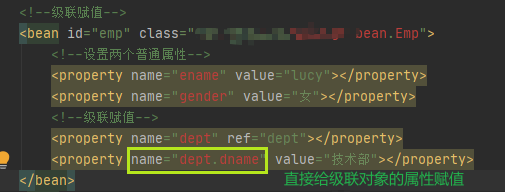1.简述
1.什么是IOC?
(1)IOC控制反转(Inversion of Control,缩写为IoC),把对象创建之间的调用过程,交给Spring进行管理
(2)为什么使用IOC? 目的:为了降低代码的耦合度
2.IOC底层原理
(1)xml解析、工厂模式、反射
3.IOC原理简述:

4.IOC(BeanFactory 接口)
1、IOC 思想基于 IOC 容器完成,IOC 容器底层就是对象工厂
2、Spring 提供 IOC 容器实现两种方式:(两个接口)
(1)BeanFactory:IOC 容器基本实现,是 Spring 内部的使用接口,不提供开发人员进行使用
特点:加载配置文件时候不会创建对象,在获取对象(使用)才去创建对象
(2)ApplicationContext:BeanFactory 接口的子接口,提供更多更强大的功能,一般由开发人员进行使用
特点:加载配置文件时候就会把在配置文件对象进行创建ApplicationContext的两个实现类一个基于文件系统FileSystem查找xml,另一个是在src目录下查找xml
public class User {
public void add(){
System.out.println("add------------");
}
}
@Test
public void testBean(){
ApplicationContext applicationContext=new ClassPathXmlApplicationContext("bean1.xml");
User user = applicationContext.getBean("user", User.class);
user.add();
}
<?xml version="1.0" encoding="UTF-8"?>
<beans xmlns="http://www.springframework.org/schema/beans"
xmlns:xsi="http://www.w3.org/2001/XMLSchema-instance"
xsi:schemaLocation="http://www.springframework.org/schema/beans http://www.springframework.org/schema/beans/spring-beans.xsd">
<bean id="user" class="com.atguigu.entity.User"></bean>
</beans>
2.IOC容器Bean管理
1、什么是 Bean 管理
(0)Bean 管理指的是两个操作
(1)Spring 创建对象
(2)Spirng 注入属性
2、Bean 管理操作有两种方式
(1)基于 xml 配置文件方式实现
(2)基于注解方式实现
基于 xml 方式创建对象
<bean id="user" class="com.xxx.entity.User">
<!--(1)在 spring 配置文件中,使用 bean 标签,标签里面添加对应属性,就可以实现对象创建-->
<!--(2)在 bean 标签有很多属性,介绍常用的属性-->
<!--* id 属性:唯一标识-->
<!-- class 属性:类全路径(包类路径)-->
<!--(3)创建对象时候,默认也是执行无参数构造方法完成对象创建-->
基于 xml 方式注入属性
DI:依赖注入,就是注入属性
第一种注入方式:使用 set 方法进行注入
(1)创建类,定义属性和对应的 set 方法

(2)在 spring 配置文件配置对象创建,配置属性注入

第二种注入方式:使用有参数构造进行注入
(1)创建类,定义属性,创建属性对应有参数构造方法

(2)在 spring 配置文件中进行配置

第三种:p 名称空间注入
(1)使用 p 名称空间注入,可以简化基于 xml 配置方式
第一步 添加 p 名称空间在配置文件中

第二步 进行属性注入,在 bean 标签里面进行操作

xml 注入其他类型属性
一、字面量
(1)null 值

(2)属性值包含特殊符号

二.注入属性-外部 bean
<!--1 service 和 dao 对象创建-->
<bean id="userService" class="com.xxx.spring5.service.UserService">
<!--注入 userDao 对象
name 属性:类里面属性名称
ref 属性:创建 userDao 对象 bean 标签 id 值
-->
<property name="userDao" ref="userDaoImpl"></property>
</bean>
<bean id="userDaoImpl" class="com.xxx.spring5.dao.UserDaoImpl"></bean>
三.注入属性-内部 bean
(1)一对多关系:部门和员工
一个部门有多个员工,一个员工属于一个部门,部门是一,员工是多
(2)在实体类之间表示一对多关系,员工表示所属部门,使用对象类型属性进行表示

(3)在 spring 配置文件中进行配置

四、注入属性-级联赋值
(1)第一种写法

(2)第二种写法


五.xml 注入集合属性
1、注入数组类型属性
2、注入 List 集合类型属性
3、注入 Map 集合类型属性
(1)创建类,定义数组、list、map、set 类型属性,生成对应 set 方法

(2)在 spring 配置文件进行配置
<!--1 集合类型属性注入-->
<bean id="stu" class="com.xxx.spring5.collectiontype.Stu">
<!--数组类型属性注入-->
<property name="courses">
<array>
<value>java 课程</value>
<value>数据库课程</value>
</array>
</property>
<!--list 类型属性注入-->
<property name="list">
<list>
<value>张三</value>
<value>小三</value>
</list>
</property>
<!--map 类型属性注入-->
<property name="maps">
<map>
<entry key="JAVA" value="java"></entry>
<entry key="PHP" value="php"></entry>
</map>
</property>
<!--set 类型属性注入-->
<property name="sets">
<set>
<value>MySQL</value>
<value>Redis</value>
</set>
</property>
</bean>
4、在集合里面设置对象类型值

5、把集合注入部分提取出来
(1)在 spring 配置文件中引入名称空间 util
<?xml version="1.0" encoding="UTF-8"?>
<beans xmlns="http://www.springframework.org/schema/beans"
xmlns:xsi="http://www.w3.org/2001/XMLSchema-instance"
xmlns:p="http://www.springframework.org/schema/p"
xmlns:util="http://www.springframework.org/schema/util"
xsi:schemaLocation="http://www.springframework.org/schema/beans
http://www.springframework.org/schema/beans/spring-beans.xsd
http://www.springframework.org/schema/util
http://www.springframework.org/schema/util/spring-util.xsd">
 (2)使用 util 标签完成 list 集合注入提取
(2)使用 util 标签完成 list 集合注入提取
<util:list id="bookList">
<value>易筋经</value>
<value>九阴真经</value>
<value>九阳神功</value>
</util:list>
<!--2 提取 list 集合类型属性注入使用-->
<bean id="book" class="com.xxx.spring5.collectiontype.Book">
<property name="list" ref="bookList"></property>
</bean>
3.IOC 操作 Bean 管理(FactoryBean)
Spring 有两种类型 bean
1、Spring 有两种类型 bean一种普通 bean另外一种工厂 bean(FactoryBean)
2、普通bean:在配置文件中定义bean 类型是什么就返回什么类型
3、工厂 bean:在配置文件定义 bean 类型可以和返回类型不一样
创建工厂bean的步骤:
第一步:创建类,让这个类作为工厂 bean,实现接口 FactoryBean
第二步 :实现接口里面的方法,在实现的方法中定义返回的 bean 类型
bean的作用域(scope)
1、在 Spring 里面,设置创建 bean 实例是单实例还是多实例
2、在 Spring 里面,默认情况下,bean 是单实例对象
(1)在 spring 配置文件 bean 标签里面有属性(scope)用于设置单实例还是多实例
(2)scope 属性值
第一个值 默认值,singleton,表示是单实例对象
设置 scope 值是 singleton 时候,加载 spring 配置文件时候就会创建单实例对象
第二个值 prototype,表示是多实例对象
设置 scope 值是 prototype 时候,不是在加载 spring 配置文件时候创建 对象,在调用 getBean方法时候创建多实例对象
bean 生命周期
1、生命周期
(1)从对象创建到对象销毁的过程
2、bean 生命周期
(1)通过构造器创建 bean 实例(无参数构造)
(2)为 bean 的属性设置值和对其他 bean 引用(调用 set 方法)
(3)调用 bean 的初始化的方法(需要进行配置初始化的方法)
(4)bean 可以使用了(对象获取到了)
(5)当容器关闭时候,调用 bean 的销毁的方法(需要进行配置销毁的方法)
3、演示 bean 生命周期
public class Orders {
//无参数构造
public Orders() {
System.out.println("第一步 执行无参数构造创建 bean 实例");
}
private String oname;
public void setOname(String oname) {
this.oname = oname;
System.out.println("第二步 调用 set 方法设置属性值");
}
//创建执行的初始化的方法
public void initMethod() {
System.out.println("第三步 执行初始化的方法");
}
//创建执行的销毁的方法
public void destroyMethod() {
System.out.println("第五步 执行销毁的方法");
}
}
@Test
public void testBean3() {
// ApplicationContext context =
// new ClassPathXmlApplicationContext("bean4.xml");
ClassPathXmlApplicationContext context =
new ClassPathXmlApplicationContext("bean4.xml");
Orders orders = context.getBean("orders", Orders.class);
System.out.println("第四步 获取创建 bean 实例对象");
System.out.println(orders);
//手动让 bean 实例销毁
context.close();
}
<bean id="orders" class="com.spring5.bean.Orders" init-method="initMethod" destroy-method="destroyMethod">
<property name="oname" value="手机"></property>
</bean>

4、(完整)bean 的后置处理器,bean 生命周期有七步
(1)通过构造器创建 bean 实例(无参数构造)
(2)为 bean 的属性设置值和对其他 bean 引用(调用 set 方法)
(3)把 bean 实例传递 bean 后置处理器的方法 postProcessBeforeInitialization
(4)调用 bean 的初始化的方法(需要进行配置初始化的方法)
(5)把 bean 实例传递 bean 后置处理器的方法 postProcessAfterInitialization
(6)bean 可以使用了(对象获取到了)
(7)当容器关闭时候,调用 bean 的销毁的方法(需要进行配置销毁的方法)
5、演示添加后置处理器效果
(1)创建类,实现接口 BeanPostProcessor,创建后置处理器
public class MyBeanPost implements BeanPostProcessor {
@Override
public Object postProcessBeforeInitialization(Object bean, String beanName)
throws BeansException {
System.out.println("在初始化之前执行的方法");
return bean;
}
@Override
public Object postProcessAfterInitialization(Object bean, String beanName)
throws BeansException {
System.out.println("在初始化之后执行的方法");
return bean;
} }
(2)配置后置处理器(配置了之后会对所有bean起作用)

xml 自动装配
1、什么是自动装配
(1)根据指定装配规则(属性名称或者属性类型),Spring 自动将匹配的属性值进行注入
2、演示自动装配过程
(1)根据属性名称自动注入
<!--实现自动装配
bean 标签属性 autowire,配置自动装配
autowire 属性常用两个值:
byName 根据属性名称注入 ,注入值 bean 的 id 值和类属性名称一样
byType 根据属性类型注入
-->
<bean id="emp" class="com.spring5.autowire.Emp" autowire="byName">
<!--<property name="dept" ref="dept"></property>-->
</bean>
<bean id="dept" class="com.spring5.autowire.Dept"></bean>
(2)根据属性类型自动注入
<!--实现自动装配
bean 标签属性 autowire,配置自动装配
autowire 属性常用两个值:
byName 根据属性名称注入 ,注入值 bean 的 id 值和类属性名称一样
byType 根据属性类型注入
-->
<bean id="emp" class="com.spring5.autowire.Emp" autowire="byType">
<!--<property name="dept" ref="dept"></property>-->
</bean>
<bean id="dept" class="com.spring5.autowire.Dept"></bean>
配置外部属性文件
1、引入连接池jar包
2.直接配置
<bean id="dataSource" class="com.alibaba.druid.pool.DruidDataSource">
<property name="driverClassName" value="com.mysql.jdbc.Driver"></property>
<property name="url"
value="jdbc:mysql://localhost:3306/userDb"></property>
<property name="username" value="root"></property>
<property name="password" value="root"></property>
</bean>
3.外部属性文件配置
(1)创建属性文件

(2)把外部 properties 属性文件引入到 spring 配置文件中
- 引入 context 名称空间

<beans xmlns="http://www.springframework.org/schema/beans"
xmlns:xsi="http://www.w3.org/2001/XMLSchema-instance"
xmlns:p="http://www.springframework.org/schema/p"
xmlns:util="http://www.springframework.org/schema/util"
xmlns:context="http://www.springframework.org/schema/context"
xsi:schemaLocation="http://www.springframework.org/schema/beans
http://www.springframework.org/schema/beans/spring-beans.xsd
http://www.springframework.org/schema/util
http://www.springframework.org/schema/util/spring-util.xsd
http://www.springframework.org/schema/context
http://www.springframework.org/schema/context/spring-context.xsd">
- 在 spring 配置文件使用标签引入外部属性文件
<!--引入外部属性文件-->
<context:property-placeholder location="classpath:jdbc.properties"/>
<!--配置连接池-->
<bean id="dataSource" class="com.alibaba.druid.pool.DruidDataSource">
<property name="driverClassName" value="${prop.driverClass}"></property>
<property name="url" value="${prop.url}"></property>
<property name="username" value="${prop.userName}"></property>
<property name="password" value="${prop.password}"></property>
</bean>
基于注解方式
1、什么是注解
(1)注解是代码特殊标记,格式:@注解名称(属性名称=属性值, 属性名称=属性值…)
(2)使用注解,注解作用在类上面,方法上面,属性上面
(3)使用注解目的:简化 xml 配置
2、Spring 针对 Bean 管理中创建对象提供注解
(1)@Component
(2)@Service
(3)@Controller
(4)@Repository
上面四个注解功能是一样的,都可以用来创建 bean 实例
3、基于注解方式实现对象创建
第一步 引入依赖
 第第二步 开启组件扫描(xml context命名约束idea可自动生成)
第第二步 开启组件扫描(xml context命名约束idea可自动生成)
<!--开启组件扫描
1 如果扫描多个包,多个包使用逗号隔开
2 扫描包上层目录
-->
<context:component-scan base-package="com.atguigu">
</context:component-scan>
第三步 创建类,在类上面添加创建对象注解
//在注解里面 value 属性值可以省略不写,
//默认值是类名称,首字母小写
//UserService -- userService
@Component(value = "userService") //<bean id="userService" class=".."/>
public class UserService {
public void add() {
System.out.println("service add.......");
}
}
4、开启组件扫描细节配置(设置哪些要扫描,哪些不扫描)
<!--示例 1
use-default-filters="false" 表示现在不使用默认 filter,自己配置 filter
context:include-filter ,设置扫描哪些内容
-->
<context:component-scan base-package="com.atguigu" use-default_filters="false">
<context:include-filter type="annotation"
expression="org.springframework.stereotype.Controller"/>
</context:component-scan>
<!--示例 2
下面配置扫描包所有内容
context:exclude-filter: 设置哪些内容不进行扫描
-->
<context:component-scan base-package="com.atguigu">
<context:exclude-filter type="annotation"
expression="org.springframework.stereotype.Controller"/>
</context:component-scan>
5、基于注解方式实现属性注入
(1)@Autowired:根据属性类型进行自动装配
第一步 把 service 和 dao 对象创建,在 service 和 dao 类添加创建对象注解
第二步 在 service 注入 dao 对象,在 service 类添加 dao 类型属性,在属性上面使用注解
@Service
public class UserService {
//定义 dao 类型属性
//不需要添加 set 方法
//添加注入属性注解
@Autowired
private UserDao userDao;
public void add() {
System.out.println("service add.......");
userDao.add();
}
}
(2)@Qualifier:根据名称进行注入如果一个接口多个实现类,如果只根据类型注入就不知道注入哪一个实现类,这时就根据名称进行注入
这个@Qualifier 注解的使用,和上面@Autowired 一起使用
//定义 dao 类型属性
//不需要添加 set 方法
//添加注入属性注解
@Autowired //根据类型进行注入
@Qualifier(value = "userDaoImpl1") //根据名称进行注入
private UserDao userDao;
(3)@Resource:可以根据类型注入,可以根据名称注入
(不建议使用,因为此注解不是spring包下的)
//@Resource //根据类型进行注入
@Resource(name = "userDaoImpl1") //根据名称进行注入
private UserDao userDao;
(4)@Value:注入普通类型属性
@Value(value = "abc")
private String name;
6、完全注解开发(用配置类代替xml配置)
(1)创建配置类,替代 xml 配置文件
@Configuration //作为配置类,替代 xml 配置文件
@ComponentScan(basePackages = {"com.xxx"})
public class SpringConfig {
}
(2)编写测试类




























 1万+
1万+











 被折叠的 条评论
为什么被折叠?
被折叠的 条评论
为什么被折叠?








